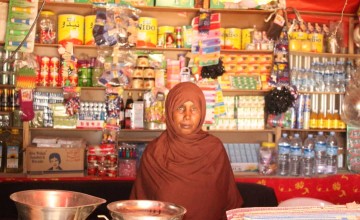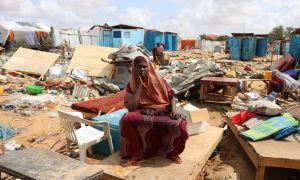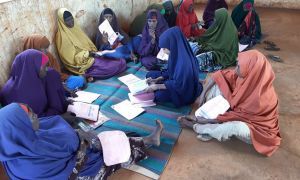
Read our 2023 annual report

Knowledge Hub
Wadajir: Enhancing Durable Solutions for, and Reintegration of, Displacement Affected Communities in Somaliland - Endline Evaluation 2020
The Wadajir project – Enhancing Durable Solutions for, and Reintegration of, Displacement Affected Communities – was carried out in two districts of Somaliland, Hargeisa and Burao.

The three-year project, funded by the EU within its RE-INTEG programme, was implemented by the Somaliland Durable Solutions Consortium, comprising World Vision, the Danish Refugee Council, Norwegian Refugee Council, Concern Worldwide, Taakulo Somaliland Community and Regional Durable Solutions Secretariat. The consortium cooperated closely with the Ministries of Planning and National Development, Education, Health, Employment Social Affairs and Family, and the National Displacement and Refugee Agency.
The four result areas of the project were concerned with improving the ability of the targeted displacement-affected communities to participate in decision-making structures, increasing their access to basic services, improving their access to livelihoods through skill training and seed capital, and disseminating lessons learnt about finding durable solutions to the problems faced by displacement affected communities.
The evaluation
The consultancy firm, iDC, carried out the evaluation during late February and early March 2020. The objective of the evaluation was to document the achievements and challenges of the project in terms of the conventional evaluation criteria of Relevance, Effectiveness, Efficiency, Sustainability and Impact. This evaluation report also draws a number of key lessons and makes recommendations that could be taken up in any extension of the Wadajir project or in any similar project elsewhere.
The evaluation methods were both quantitative and qualitative. A survey questionnaire was administered to 1,034 households of the displacement-affected communities (609 in Hargeisa and 425 in Burao). The data collection for the survey happened concurrently in both locations using the KoBoCollect application installed on the smartphones of the enumerators. Interviews were held with 32 key informants (20 in Hargeisa and 12 in Burao); five focus group discussions were carried out with beneficiaries, but only in Hargeisa. In both Hargeisa and Burao, FGDs were held with beneficiaries by the staff of the relevant government ministries, under a separate World Vision contract with the Ministry of Planning and National Development, but these fieldwork reports have not been made available to the iDC team.
Key findings
Relevance
The report considers two main aspects of the Relevance theme: the significance of the needs of the target communities, and whether the project was designed in such a way as to effectively address those needs. As the Wadajir baseline study made clear, the needs of the target displacement communities were concerned with protection and social cohesion, access to basic services, access to livelihoods training, support for income generation activities, and involvement in decision-making structures concerned with displacement. These were the needs the project went on to address. And by drawing on the different experiences of the consortium members, it was possible to cover this range of concerns. All the key informants and members of focus group discussions regarded the project as relevant.
Efficiency
The consortium arrangement has clear strengths in that it has enabled the project to draw on the different experience and expertise of the five implementing agencies – and enabled a multi-sector approach and a geographical focus. However, the iDC team suggests that there are potential weaknesses when there isn’t a sufficiently staffed project management unit in place: a reduced capacity for making implementation adjustments; split responsibilities; constrained supervision; lack of coherent programming.
In relation to the project’s M&E and reporting system, the evaluation team suggests that there has been too much reliance on figures. The statistics are important, but there is also a need to probe more deeply and tell the story behind the figures. In the routine monitoring activities, and also in the mid-term evaluation, there has been only limited attention to more qualitative methods. Key informant interviews, focus group discussions, collection of change stories can ‘reality test’ the statistical findings and better assess the quality of outputs and outcomes.
Effectiveness
This OECD/DAC theme is concerned with the achievement of outputs (activities carried out and the facilities or services put in place). In this regard, the list of achievements is an impressive one, particularly those concerned with the improvement of basic services and the support in finding employment, establishing small businesses and securing title deeds to land.
As to the appropriateness of the project’s overall strategy, it was essentially a resilience one, straddling the divide between humanitarian and development objectives: moving beyond a ‘bounce back’ objective to a ‘bounce back better’ one. The aim was to increase the life and livelihood choices for the DACs. And the findings of both the household survey, the interviews with stakeholders and beneficiaries, confirm the successes of that strategy.
Impact
In relation to Outcome 1, which is concerned with establishing a conducive environment for the displaced communities, the household survey found that 84% of the respondents said that they were able to voice their concerns; whereas, only 22% said had said this at the baseline. And 80% of the respondents said that they believed government duty bearers were responsive to the issues raised by them – as opposed to 61% in the baseline study. For Outcome 2, concerned with safety and basic services, 98% of the survey respondents said that they feel safe and able to move freely in their communities – and, in this regard, the figure was also a high 94% at the time of the baseline study. A number of participants in the interviews and discussions pointed to the project’s awareness-raising programme as having changed the attitude of many IDPs about GBV crimes – and had resulted in a reduction in crimes. And there was general appreciation for the improvements in health and water services.
With regard to Outcome 3, focusing on improvements in livelihoods and income generation, 66% of the beneficiaries said that their income had increased since the project started. There was general appreciation of the skills training that had been provided and start-up capital made available for setting up small businesses. The ‘change stories’ included in the report illustrate the impact that such initiatives can have on individuals and families. Outcome 4 was ambitious: that learning recommendations would actually be incorporated in district, regional and national policies. This might not have happened yet, but the dissemination of the ReDSS research reports and the engagement with ministries and the two local authorities has meant that ideas have been shared, and the project must have influenced the way in which these government agencies address issues related displacement.
Sustainability
Three factors are normally taken into account when assessing the likely sustainability of a project: whether there will be government support, whether the capacities have been built for those who will continue activities, and whether there will be funding.
Given the engagement with the relevant ministries and, especially, the National Displacement and Refugee Agency, government support for any possible extension or replication of the project is clear. As to whether capacities have been built, in that this has been essentially a capacity-building project, the acquired knowledge of the various duty bearers, whether in health or protection services, will be retained. Also, the vocational and business enterprise skills acquired by the trainees will not be lost. For supporting an extension or replication of the project – and the case for doing this is a strong one – the funding will have to come from external donors.
Lessons learnt
This report had highlighted four lessons that have been learnt:
- There is a need for a PMU in such a consortium implemented project;
- There is a need to strike a balance between quantitative and qualitative M&E and reporting systems;
- It is necessary to acknowledge the rich talent that is to be found within displacement-affected communities;
- It is possible and beneficial to carry out joint evaluations.
The Durable Solutions programmes were a feature of Concern’s publication Knowledge Matters – Durable Solutions in Somalia.
Download the evaluation report
This project was funded by the EU within its RE-INTEG programme. The views expressed herein should not be taken, in any way, to reflect the official opinion of the European Union, and the European Commission is not responsible for any use that may be made of the information it contains.




